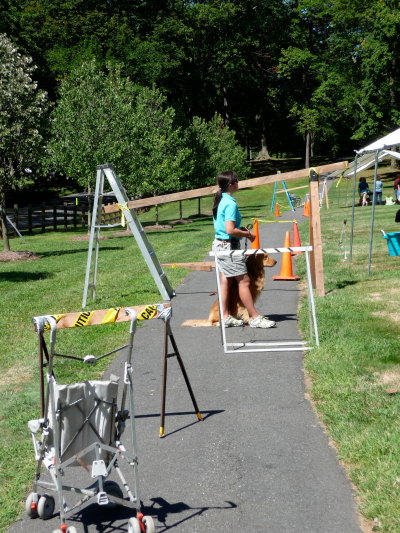I figured that once I told the animal sciences department at University of Illinois that Harper wouldn’t be coming with me, they’d cancel my guest lecture to their animal sciences class tomorrow. But I was wrong. Professor Amy Fisher wants me to come anyway, and I think the talk will be interesting. My plan is to use Harper’s early retirement as an example of just how difficult it is to prepare Seeing Eye dogs for the hard, hard work required of them.
From the Seeing Eye Web site:
Staff instructors are full-time employees who hold college degrees from various fields of study and have successfully completed three years of specialized on-the-job training. They relate well to dogs and people and are physically fit, since their jobs are physically demanding and involve working outdoors in all weather. Some of our current instructors came from teaching, business consulting and rehabilitation fields. Some were in the military and worked with dogs before, and many started out as kennel assistants here at The Seeing Eye.

A Seeing Eye trainer demonstrates how dogs learn to negotiate obstacles.
When people express interest in pursuing a job training guide dogs, I always remind them that they won’t just be working with dogs. They’ll be working with people, too. We blind folks are all different ages, and we have all sorts of different backgrounds and experiences behind us. Some of us are newly blind and still adjusting, others have been blind our entire lives. Although some of us might be easy to work with, a lot of us are brats. We test our teacher’s patience.
The Puppy Place (a Web site created by a group of volunteers who raise puppies for guide dog schools) says it well:
Guide Dog trainers must work with a variety of dogs within a given size range. A great deal of walking and upper body strength is required to mold hyper young dogs into responsible workers. In the beginning, when working with dogs alone, this may not seem bad, but soon the apprentice must team dog training with people training. You can’t leash correct your blind student, or give him/her a dirty look and expect the undesired behavior or wrong actions to stop. You must verbally communicate while physically managing to keep up with the dog. Coming out of yourself to work with both dogs and people is a special skill and not one to be taken lightly.
Schools receive literally hundreds of applications a year from people who want to train guide dogs, so even opportunities to become an apprentice are rare. Most guide dog schools do require instructors to do an apprenticeship, and some apprenticeships last as long as four years. From my observation, apprentices work very hard. And from what I hear, salaries are not that high. Considering that guide dog schools are non-profit organizations, I would guess the pay is far below what a lot of today’s college educated people expect to earn.
If you’re looking for job satisfaction, though, this kind of work must be pretty dang rewarding! For general information about working for The Seeing Eye, contact:
Human Resources
The Seeing Eye
P.O. Box 375
Morristown, NJ 07963
or email jobs@seeingeye.org.
I believe there are 10 accredited schools in the U.S., and a few in Europe, U.K. in particular. The pay is low, the demands high, the work rewarding, according to the trainers we’ve known. Just thought I’d expand the horizon for anyone actually considering the challenge of taking sweet, smart puppies and molding them into dependable guide dogs for people (who are often less sweet and sometimes less smart).
Lauren, you are the greatest. Love your comment about the *human* trainees often being less sweet and sometimes less smart – so true!
And yes, there are many accredited schools that train guides for people who are blind, in addition to those in Europe and the UK I’ve heard of places in South Korea, Japan and Australia. I am most familiar with the Seeing Eye in NJ, so that’s why I singled them out in this post.
The Seeing Eye instructors have my utmost respect and admiration…..what they do amazes me. I have enough trouble training my little rug rat….and whatever they make….it isn’t enough!
Such appreciation for these people and as you describe so well the multifacets of their job.
Hi Beth
I am in awe of the work the instructors, guide dogs and guided people do. Hanni was the first guide dog I had close contact with. (Love at first sight)
She and you gave me a deep insight of the work, love and respect that is evident in training, and living with a guide dog.
I raise my cup of java to the Instructors, Dogs and Guided People.
Looking forward to meeting your new guide companion.
Your partner in the B & D team Wanda B
Leave a Response